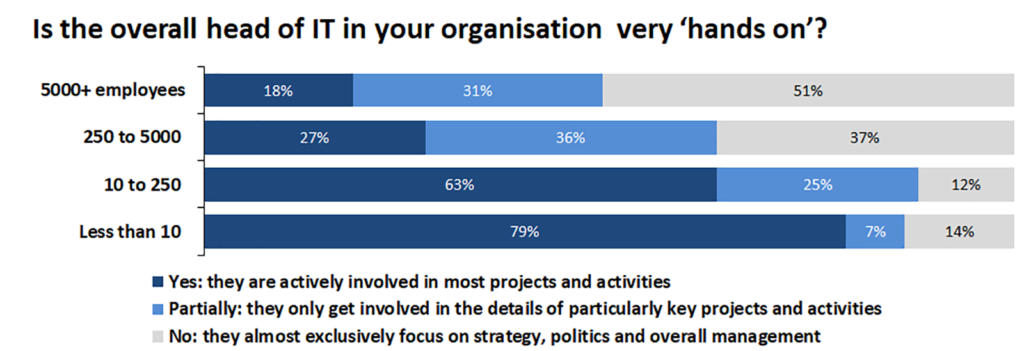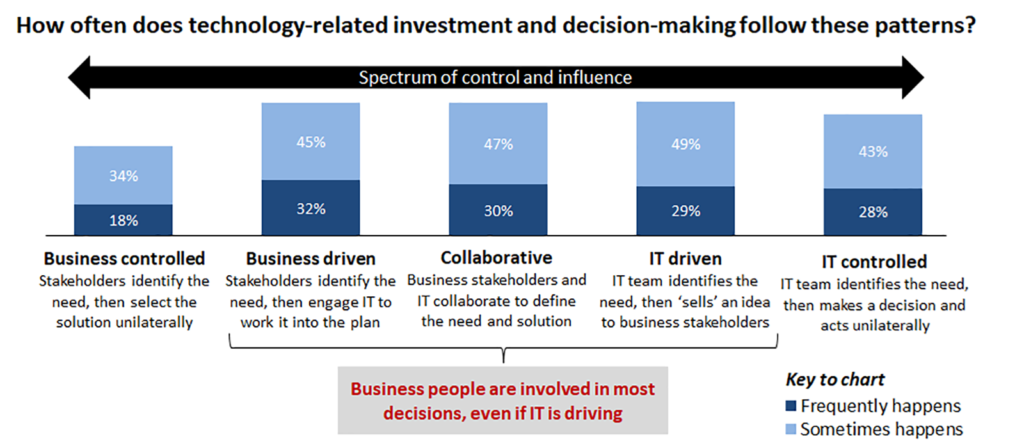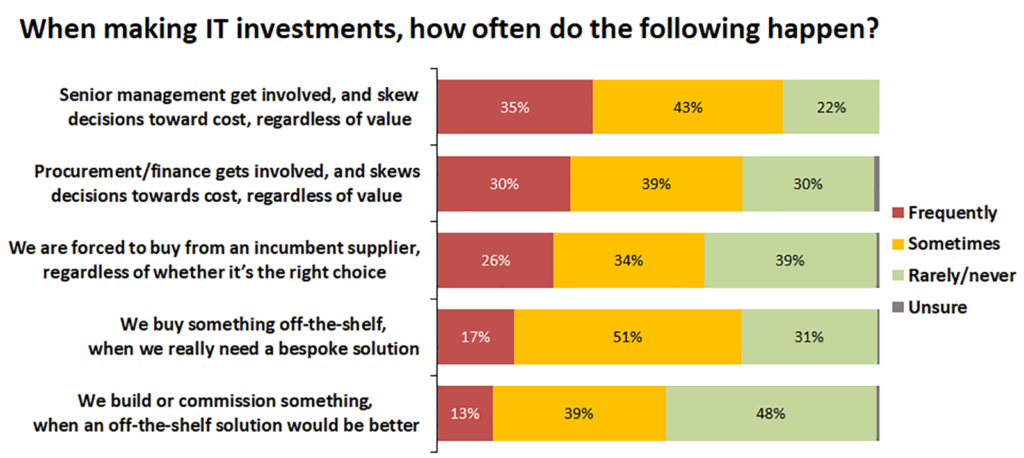
Some writers love a battle – or at least, the idea of one. So they exaggerate perfectly normal differences of opinion, spinning debates into fierce zero-sum conflicts where there can be only one winner.
It is almost as true in IT as it is in politics. In recent years – perhaps even for the last decade – much has been written about how data centre managers and IT professionals in general are losing out, as business managers and departmental heads seize their authority to acquire systems and solutions. Some have even postulated that in the not too distant future, IT inside business will dwindle in importance as ‘the business’ decides instead what IT to use and how it would be consumed.
Such an extreme is obviously unlikely to occur in any sizeable organisation, but the question remains, who is influencing IT decision making and to what extent are data centre professionals in control? An online study by Freeform Dynamics of over 1,100 IT professionals involved in IT acquisitions throws some light on matters which many of us take for granted, but which could probably benefit from greater attention. The study highlights how broad the community involved in IT decision making is and how their thoughts are shaped over time. And the main finding is that the “war between business and IT” is fake news.
There is a second common assumption that we ought to question, as well. This time it is one that is held dear by many large IT vendors and salespeople, and it’s the belief that “it’s the CIO we need to influence” (Figure 1).

Again, our survey finds that the truth is rather different. The results here highlight that except in small and very small organisations, the head of IT is likely to be heavily involved only in decisions of a very strategic nature. Indeed, in the largest of organisations they are more likely to not be involved directly in even the most important IT decisions. So who is helping shape such decisions?
Any reader who works in the data centre knows that IT decision making can be complex, especially when it comes to selecting what systems, software, management and security tools to acquire. Even decisions about the very basics of a data centre can be influenced by non-IT stakeholders, particularly if the subject under discussion is the data centre itself – should we rebuild, should we move to a CoLo, should we migrate to “The Cloud”. Clearly these are often just as much about politics as they are about cost and technology. But what about more “routine” decisions (Figure 2)?

Figure 2 illustrates that decision making in IT really can be a team sport, but as might be expected, everything depends on context. As some commentators say, there are situations where technology-related investment decisions are controlled entirely by the line of business. Most of these are likely to be applications or services that the business unit can acquire easily to meet a particular need, and that (hopefully at least) doesn’t need to integrate with any data centre systems.
But, and it is a big “but”, the same can still be said about IT controlling and making decisions unilaterally. In some areas of data centre technology acquisition, it is obvious that IT is likely to be in the decision driving seat. After all there are few business managers who want to understand the intricacies of storage, compute and networking. All they want to know is that it provides them with the service levels they require.
However, many investment decisions are made, and indeed have long been made, by business and IT staff working together. In some cases, the business may identify a need and, perhaps, even a solution and ask IT to make it happen. This is entirely logical.
Perhaps the most interesting facet of this chart concerns the IT Driven result. In these we can see that there are many occasions, perhaps more than ever before, where IT itself is identifying opportunities where technology investment could help the business and then selling the idea to business stakeholders to get their buy in. This is something where until recently many IT teams have struggled. And equally encouragingly, it is clear that IT and business stakeholders can, and are, working closely together to define needs and find solutions.
But don’t think that everything always runs smoothly, especially if an IT investment project runs into trouble. Another study carried out by Freeform Dynamics shows that people issues can cause problems (Figure 3).

The results here do not say that these issues happen all the time, or even that they happen often. But when they do occur, the consequences are serious. This shows that IT and business people still need help working together, especially to ensure that both sides fully understand each other. Interpersonal relationship training can be a fruitful investment in and of itself.
While the idea of IT and business teams working together is great in theory, some practical issues keep on cropping up that can derail investment decisions. But we should also recognise that such collaborative teamwork between IT and business does not always run smoothly. Another result from the report mentioned above illustrates some of the ways in which investment decisions can still go off track (Figure 4).

The biggest two issues remain cost, namely that either senior business managers may want to overrule some technology acquisitions in order to drive down associated costs. Alternatively, the dreaded “Procurement” team can have a similar impact, usually because the KPIs on which they are judged have nothing to do with the business value delivered by an acquired solution, IT or any other, but simply by how much they can reduce the project’s cost base.
The other challenge here can arrive when the organisation has a preferred supplier system in place and the solution being sought is from a vendor not on the existing list. All three of these are process and internal politics issues which, as we all know, are not the simplest to fix quickly.
The IT press and some vendor marketing departments have expended considerable energy over the years trying to convince us that IT and the business are at war with each other. This is plainly untrue and has always been wildly inaccurate. IT and business managers have always cooperated to get new projects into use, and things are getting better all the time as both sides accrue more experience and as personal relationships deepen.
Business needs IT solutions and it requires they be available more quickly than ever before and be able to change rapidly as the market environment modifies. This demands IT and business work effectively and efficiently, but as Figure 3 above shows, some human skills development on both sides would not go amiss. But in times when misleading headlines and publicity are common, don’t let anyone tell you there is a war going on between IT and the business when it comes to tech procurement. Sure, there may be the odd skirmish, but by and large everyone wants the same thing, for the business to win.